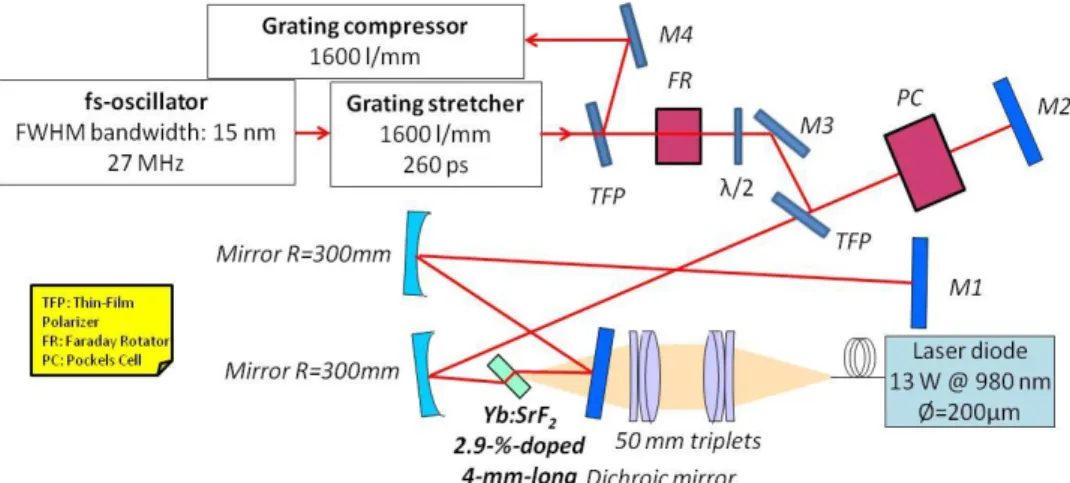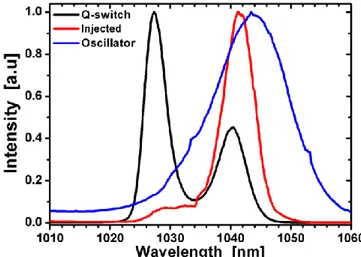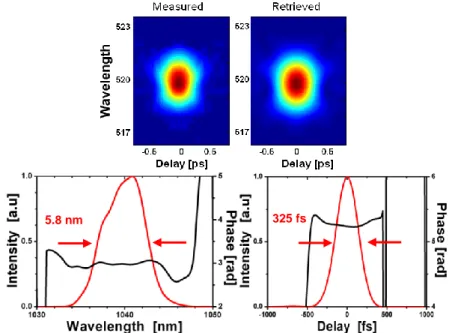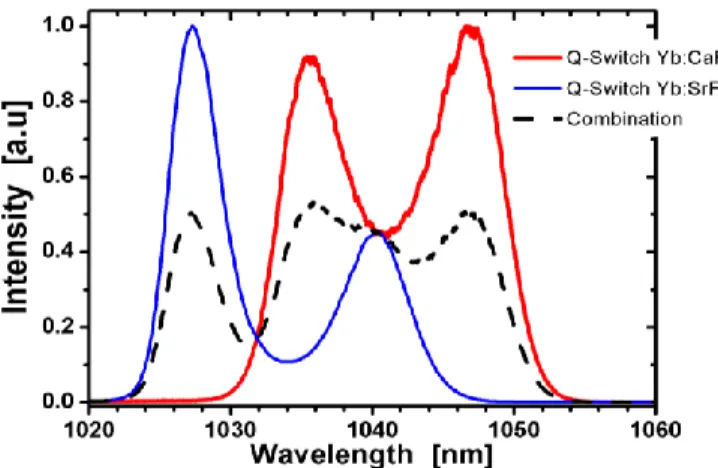HAL Id: hal-00657866
https://hal-iogs.archives-ouvertes.fr/hal-00657866
Submitted on 9 Jan 2012
HAL is a multi-disciplinary open access
archive for the deposit and dissemination of
sci-entific research documents, whether they are
pub-lished or not. The documents may come from
teaching and research institutions in France or
abroad, or from public or private research centers.
L’archive ouverte pluridisciplinaire HAL, est
destinée au dépôt et à la diffusion de documents
scientifiques de niveau recherche, publiés ou non,
émanant des établissements d’enseignement et de
recherche français ou étrangers, des laboratoires
publics ou privés.
Diode-pumped regenerative Yb:SrF2 amplifier
Sandrine Ricaud, Patrick Georges, Patrice Camy, Jean-Louis Doualan,
Richard Moncorgé, Antoine Courjaud, Eric Mottay, Frédéric Druon
To cite this version:
Sandrine Ricaud, Patrick Georges, Patrice Camy, Jean-Louis Doualan, Richard Moncorgé, et al..
Diode-pumped regenerative Yb:SrF2 amplifier. Applied Physics B - Laser and Optics, Springer Verlag,
2012, 106 (4), pp.823-827. �10.1007/s00340-011-4783-x�. �hal-00657866�
Diode-pumped regenerative Yb:SrF
2
amplifier
Sandrine Ricaud1,3,*, Patrick Georges1, Patrice Camy2, Jean-Louis Doualan2, RichardMoncorgé2, Antoine Courjaud3, Eric Mottay3 and Frédéric Druon1
1Laboratoire Charles Fabry de l’Institut d’Optique (LCFIO), UMR 8501 CNRS, Université Paris-Sud, RD 128 Campus Polytechnique, 91127 Palaiseau, France
2Centre de recherche sur les Ions, les Matériaux et la Photonique (CIMAP), UMR 6252 CEA CNRS-ENSICaen, Université de Caen, 14050 Caen, France 3Amplitude Systèmes, 6 Allée du Doyen Georges Brus, 33600 Pessac, France
* sandrine.ricaud@institutoptique.fr
Abstract: We report what we believe to be the first Yb:SrF2 regenerative
femtosecond amplifier. The regenerative amplifier produces 325-fs pulses at 100-Hz repetition rate with an energy before compression of 1.4 mJ. The interest of Yb:SrF2 in such regenerative amplifiers and its complementarity
to its well-known isotype Yb:CaF2 is also discussed.
2011 Optical Society of America
OCIS codes: (140.3280) Laser amplifiers; (140.3380) Laser materials; (140.3480) Lasers, diode-pumped; (140.3615) Lasers, ytterbium; (320.7090) Ultrafast lasers.
References and links
1. M. Grishin, V. Gulbinas, A. Michailovas, “Dynamics of high repetition rate regenerative amplifiers,” Opt. Express 15, 9434-9443 (2007).
2. P. Camy, J.L. Doualan, A. Benayad, M. von Edlinger, V. Ménard and R. Moncorgé, “Comparative spectroscopic and laser properties of Yb3+-doped CaF
2, SrF2 and BaF2 single crystals,” Appl. Phys. B
89(4), 539-542 (2007).
3. J.L. Doualan, P. Camy, A. Benayad, V. Ménard, R. Moncorgé, J. Boudeile, F. Druon, F. Balembois and P. Georges, “Yb3+Doped (Ca,Sr,Ba)F
2 for High Power Laser Applications,” Laser Physics 20(2), 533-536
(2010).
4. C. R. A. Catlow, A. V. Chadwick, G. N. Greaves, and L. M. Moroney, “Direct observations of the dopant environment in fluorites using EXAFS,” Nature 312, 601-604 (1984).
5. M. Siebold, S. Bock, U. Schramm, B. Xu, J. L. Doualan, P. Camy, and R. Moncorgé, “Yb:CaF2 — a new
old laser crystal,” Appl. Phys. B 97(2), 327-338 (2009).
6. V. Petit, P. Camy, J.-L. Doualan, X. Portier, and R. Moncorgé, “Spectroscopy of Yb3+:CaF
2: From isolated
centers to clusters” Phys. Rev. B 78, 085131 (2008).
7. M. Siebold, M. Hornung, R. Boedefeld, S. Podleska, S. Klingebiel, C. Wandt, F. Krausz, S. Karsch, R. Uecker, A. Jochmann, J. Hein, and M. C. Kaluza, “Terawatt diode-pumped Yb:CaF2 laser,” Opt. Lett.
33(23), 2770-2772 (2008).
8. S. Ricaud, F. Druon, D. N. Papadopoulos, P. Camy, J.-L. Doualan, R. Moncorgé, M. Delaigue, Y. Zaouter, A. Courjaud, P. Georges, and E. Mottay, “Short-pulse and high-repetition-rate diode-pumped Yb:CaF2
regenerative amplifier,” Opt. Lett. 35, 2415-2417 (2010).
9. A. Pugžlys, G. Andriukaitis, D. Sidorov, A. Irshad, A. Baltuška, W. J. Lai, P. B. Phua, L. Su, J. Xu, H. Li, R. Li, S. Ališauskas, A. Marcinkevicius, M. E. Fermann, L. Giniunas, and R. Danielius, “Spectroscopy and lasing of cryogenically cooled Yb,Na:CaF2,” Appl. Phys. B 97, 339-350 (2009).
10. G. Andriukaitis, D. Kartashov, D. Lorenc, A. Pugžlys, A. Baltuška, L. Giniunas, R. Danielius, and J. Limpert “Pulse Compression of 6mJ, 200-fs Pulses from a cw-Diode-Pumped Single-Stage Yb:CaF2
MOPA in a Hollow Fiber” in High-Intensity Lasers and High-Field Phenomena, (Optical Society of America, 2011), paper HWA5.
11. M. Siebold, J. Hein, M. C. Kaluza, and R. Uecker, “High-peak-power tunable laser operation of Yb:SrF2,”
Opt.Lett. 32, 1818-1020 (2007).
12. T. T. Basiev, M. E. Doroshenko, P. P. Fedorov, V. A. Konyushkin, S. V. Kuznetsov, V. V. Osiko, and M. Sh. Akchurin, “Efficient laser based on CaF2-SrF2-YbF3 nanoceramics,” Opt. Lett. 33, 521-523 (2008).
13. J. Šulc, H. Jelínková, M. E. Doroshenko, T. T. Basiev, V. A. Konyushkin, and P. P. Fedorov, “Tunability of Lasers Based on Yb3+-Doped Fluorides SrF2, SrF2-CaF2, SrF2-BaF2, and YLF,” in Advanced Solid-State
Photonics, OSA Technical Digest Series (CD) (Optical Society of America, 2009), paper WB16.
14. O. K. Alimov, T. T. Basiev, M. E. Doroshenko, P. P. Fedorov, V. A. Konyushkin, S. V. Kouznetsov, A. N. Nakladov, V. V. Osiko, H. Jelinkova, and J. Šulc, “Spectroscopic and Oscillation Properties of Yb3+
BaF2-SrF2-CaF2 Crystals and Ceramics,” in Advanced Solid-State Photonics, OSA Technical Digest Series
(CD) (Optical Society of America, 2009), paper WB25.
15. P. Aubry, A. Bensalah, P. Gredin, G. Patriarche, D. Vivien, and M. Mortier, “Synthesis and optical characterizations of Yb-doped CaF2 ceramics,” Opt. Mater., 31 (2009) 750-753.
16. F. Friebel, F. Druon, J. Boudeile, D. N. Papadopoulos, M. Hanna, P. Georges, P. Camy, J. L. Doualan, A. Benayad, R. Moncorgé, C. Cassagne, and G. Boudebs, “Diode-pumped 99 fs Yb:CaF2 oscillator,” Opt.
Lett. 34(9), 1474-1476 (2009).
17. F. Druon, D. N. Papadopoulos, J. Boudeile, M. Hanna, P. Georges, A. Benayad, P. Camy, J. L. Doualan, V Ménard, and R. Moncorgé, “Mode-locked operation of a diode-pumped femtosecond Yb:SrF2 laser,” Opt.
Lett. 34, 2354-2356 (2009).
18. J. Boudeile, J. Didierjean, P. Camy, J. L. Doualan, A. Benayad, V. Ménard, R. Moncorgé, F. Druon, F. Balembois, and P. Georges, “Thermal behaviour of ytterbium-doped fluorite crystals under high power pumping,” Opt. Express 16, 10098-10109 (2008).
19. D. N. Papadopoulos, F. Druon, J. Boudeile, I. Martial, M. Hanna, P. Georges, P. O. Petit, P. Goldner, and B. Viana, “Low-repetition-rate femtosecond operation in extended-cavity mode-locked Yb:CALGO laser,” Opt. Lett. 34, 196-198 (2009).
20. http://cmdo.cnrs.fr/ and http://www.lasur-femto.cnrs.fr/
1. Introduction
The rising demand for efficient micro-processing laser sources has led to the development of high repetition rate ultra-short pulse solid-state lasers. Regenerative amplifiers permit amplification of ultra-short pulses with a gain of several orders of magnitude [1]. However, gain narrowing limits the pulse duration after amplification so that crystals with broad gain spectrum are needed to obtain really short pulses. Furthermore, an energy level around 1 mJ is required, which implies that materials with long fluorescence lifetimes should be used.
Spectroscopic and thermal properties of ytterbium-doped (Ca, Ba, Sr)F2 laser crystals
make them ideal candidates for high power laser applications [2,3]. Their crystallographic properties are well-known [4]. Specifically, there has been a recent renewed interest in Yb:CaF2 [5]. Indeed, its high thermal conductivity, 9.7W.m-1.K-1 for an undoped crystal, its
broad and smooth emission and absorption cross sections, owing to the particular Yb3+ cluster responsible for the lasing properties inside the doped crystal [4,6], and its long fluorescence lifetime (2.4 ms), enable the generation of energetic laser pulses at different repetition rates. Based on Yb:CaF2, a terawatt system already generated 197-mJ, 192-fs pulses at a repetition
rate of 1 Hz [7], and a regenerative amplifier system was used to generate 0.8-mJ, 178-fs pulses at a 500 Hz repetition rate [8]. Furthermore, at cryogenic temperature, a co-doped Yb3+,Na+:CaF2 amplifier [9] has delivered 173-fs, 2.5-mJ pulses at a 1 kHz repetition rate and
a Yb3+:CaF2 amplifier has already produced 200-fs, 6-mJ pulses at 500 Hz repetition rate
[10].
At room temperature the spectroscopic characteristics of Yb:CaF2 and Yb:SrF2 are very
similar. However, each of them has its own advantages, a higher peak absorption cross section around 980 nm and a longer fluorescence lifetime (2.9 ms) for Yb:SrF2 [2,11], and a
wider and larger gain cross section spectrum for Yb:CaF2 [2]. In a regenerative amplifier
configuration, the longer fluorescence lifetime is crucial since it permits higher energy storage, which leads potentially to higher energy pulses with repetition rates in the 100 Hz range. We also notice that the Yb:SrF2 gain cross section spectrum is shifted to shorter
wavelengths in comparison to the Yb:CaF2 one. This is interesting for addressing different
wavelengths.
Moreover, reference [2] indicates that crystal growth seems to lead to comparable optical qualities. Indeed for a 2.6%Yb-doped CaF2 and a 2.9%Yb-doped SrF2, the authors measured
about the same laser threshold, the same slope efficiency and the same wavelength tunability. Furthermore, because of the simple cubic structure of these materials, high optical quality ceramics can be prepared [12-15]. Indeed, laser oscillations under diode pumping have been
recently obtained with slope efficiencies not far from those obtained with single crystals of similar compositions [12-14].
Finally, these very close properties have also permitted to obtain, with single crystals, relatively similar results in femtosecond operation. Ultra-short mode-locked oscillators have been demonstrated, with a pulse duration of 99 fs and an average output power of 380 mW for Yb:CaF2 [16], and 143 fs with a power of 450 mW for Yb:SrF2 [17]. The pulse duration
was shorter with Yb:CaF2 because of Kerr lens-assisted mode-locking, which was not
observed in the case of Yb:SrF2 because of stability concern probably due to the longer
emission lifetime of Yb:SrF2 compared to Yb:CaF2.
From the amplification point of view, the longer lifetime of Yb:SrF2 becomes a strong
advantage for energy storage. In fact, the operating regimes addressed by these two crystals in amplifier configuration are not exactly the same: for high average power laser amplification, Yb:CaF2 shows more interesting thermal properties [18], whereas, from the point of view of
energy storage and energy extraction, Yb:SrF2 seems more appropriate, especially at low
repetition rate. It is therefore interesting to investigate the potential of Yb:SrF2 in a
regenerative amplifier and compare the results with its more popular isotype Yb:CaF2.
For that purpose, we present here a room-temperature diode-pumped Yb:SrF2
regenerative amplifier, in order to compare the performances of Yb:SrF2 to Yb:CaF2 and
discuss its potential in short-pulse amplifiers.
2. Experimental setup
The experiment is performed with a 4-mm-long, 2.9%Yb-doped SrF2 crystal positioned at
Brewster angle and mounted on a copper holder inside the cavity. The cavity is presented in fig. 1, and is very similar to the one described in [8], which is essential to allow a good comparison with the 2.6%Yb-doped CaF2.
Fig. 1 Experimental setup
The seed pulses are generated by a broadband Yb:CALGO oscillator, at a repetition rate of 27 MHz [19], with a spectrum of 15 nm centered at 1043 nm. They are stretched up to 260 ps with a transmission grating (1600 l/mm). Then, a thin-film polarizer (TFP), a Faraday rotator and a half-wave plate separate the input and the output beam of the regenerative amplifier. The regenerative cavity has a length around 1.5 m, contains a TFP and a BBO Pockels cell (PC) for polarization switching, to inject seed pulses from the oscillator and extract amplified pulses. The PC acts as a quarter-wave plate at 45° in static regime, and as a half-wave plate with high voltage. The crystal is longitudinally pumped through a dichroic mirror by a 13W-fiber-coupled laser diode, emitting at 980 nm (200 µm core diameter with a NA of 0.22).
We optimize the overlap between the laser and the pump beams inside the crystal using two 50-mm focal length triplets, resulting in a focal spot of 200 µm. The chirped pulses are finally compressed with two transmission gratings (1600 l/mm) with an overall efficiency of 60%.
3. Results
The Q-switched regime permits to evaluate the achievable energy, average power and spectrum before regenerative configuration. At a low repetition rate of 100 Hz, we obtain up to 1.4 mJ, and at a high repetition rate of 5 kHz, the power is 580 mW. The spectrum presents two peaks (fig. 2) at 1027 and 1040 nm. The peak at 1027 nm is the highest, so that despite the shift between the oscillator spectrum and the Yb:SrF2 gain bandwidth, we expect the
amplified spectrum to be shifted towards shorter wavelengths. In order to benefit from the entire gain spectrum we use a broad spectral bandwidth oscillator centered at 1040 nm that exhibits a low but non-negligible spectral intensity at 1027 nm. In this case the lower gain peak at 1040 nm is seeded with more spectral energy density than the intense peak at 1027 nm to counterbalance the smaller gain at 1040 nm.
Fig. 2 Evolution of the spectrum in Q-switched and injected regime (black-red), and oscillator spectrum (blue)
The obtained amplified spectrum shown in fig. 2 shows that the wavelength shift between the oscillator and the amplifier gain is too large and does not allow broadband amplification, since only a weak shoulder appears on the short wavelength side of the amplified spectrum. In these conditions, the spectral bandwidth (FWHM) of the amplified pulse is only 5.8 nm (fig. 2). This leads to a pulse duration of about 330 fs almost independent of the repetition rate. The pulse duration with Yb:SrF2 is longer than with Yb:CaF2 (178 fs) because in the
latter case it was possible to amplify simultaneously the two peaks located at 1036 nm and 1047 nm.
With Yb:SrF2, at 100 Hz repetition rate, we obtain a pulse duration of 325 fs for a
spectral bandwidth of 5.8 nm (FWHM), as measured with a frequency-resolved optical gating (SHG-FROG) and an autocorrelator (fig. 3). The Fourier transform-limited pulse duration with this measured spectrum is 305 fs. The difference comes from a small amount of high-order uncompensated spectral phase as shown on the SHG-FROG phase measurement (fig. 3). The energies before and after compression are 1.4 mJ and 850 µJ respectively, which leads to an-optical-to-optical efficiency of 1.1% before compression. Furthermore, with a pump absorption of 52%, the laser/absorbed pump power efficiency is about 2.1%. We think, this relatively low efficiency is mainly due to a lower gain compared to Yb:CaF2. The
build-up time in the present case is 1.7 µs compared to 1.4 µs in the case of Yb:CaF2. The beam
profile has a Gaussian shape, with M2 < 1.1 both in vertical and horizontal directions.
Fig. 3 Recompressed pulse measurement with SHG-FROG at 100-Hz repetition rate
The pulse energy and average output power versus repetition rate are plotted in figure 4 after compression. At high repetition rate, the energy is strongly reduced and the output power reaches 540 mW before compression and 320 mW after. In these conditions, the optical-to-optical efficiency is 4.2 % prior to compression, and due to the pump absorption increase to 58 %, we obtain a laser/absorbed pump power efficiency of 7.2 %.
Fig. 4 Evolution of output pulse energy and average power after compression versus repetition rate
4. Discussion
We have obtained shorter pulses with an Yb:CaF2 regenerative amplifier, mainly due to the
better overlap between the oscillator and the Yb:CaF2 gain spectra. Indeed, the Yb:SrF2 gain
spectrum is shifted to shorter wavelengths, and only a part of the spectrum is amplified. The spectrum obtained in the Q-switched regime gives information about the material gain spectrum. In this regime, when we observe (fig. 5) spectra obtained with Yb:CaF2 and
325 fs 5.8 nm
Yb:SrF2, we notice that they are remarkably complementary. In fact, the two spectra have a
“camel” shape, with peaks located at 1027 and 1041 nm and a dip at 1036 nm for Yb:SrF2,
and peaks at 1036 and 1047 nm and a dip at 1041 nm for Yb:CaF2. Thus, by combining the
two materials we should obtain a broadband gain spectrum between 1025 and 1050 nm. Seeded by a broadband oscillator, with a spectrum centered at 1038 nm, a regenerative amplifier with both crystals in the cavity should lead to sub-100fs laser pulses, with the potential for a few millijoules pulses at a high repetition rate.
Fig. 5 Yb:SrF2 and Yb:CaF2 spectra in a Q-switched regime
Another way to obtain this very broad spectrum with both crystals is to combine them into one single mixed Yb:CaxSr1-xF2 crystal or ceramic [12-14]. As already demonstrated in
reference [13], smooth and very broad spectra can be obtained for example with Yb:CaF2
-SrF2 and Yb:SrF2-BaF2 materials.
5. Conclusion
We have demonstrated the first diode-pumped Yb:SrF2 regenerative amplifier at high
repetition rate. At a 100 Hz repetition rate, we obtain 330-fs pulses with an energy of 850 µJ (after compression). The highest average power achieved at high repetition rate is 540 mW prior to compression, which corresponds to an optical-to-optical efficiency of 4.2%. These results are interesting despite the fact they are less impressive than with Yb:CaF2 in the same
conditions. Indeed, the gain spectra of these crystals happen to be very complementary, and open an almost flat gain window between 1025 nm and 1050 nm. Shorter pulses with a high energy at a high repetition rate should be obtained by seeding the amplifier with a broadband oscillator centered at 1034 nm, and by using a combination of Yb:CaF2 and Yb:SrF2 crystals.
6. Acknowledgments
This work was supported by the CMDO+ and FEMTO [20] CNRS-MRCT networks through the entitled CRYBLE program, and by the Agence Nationale de la Recherche (ANR) through the entitled FEMTOCRYBLE project.



